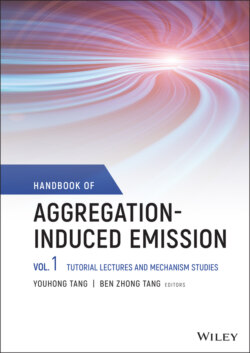Читать книгу Handbook of Aggregation-Induced Emission, Volume 1 - Группа авторов - Страница 14
1.1 Introduction
ОглавлениеMolecular motions drive most natural processes, ranging from the formation and annihilation of astronomical objects to the metabolism of microbes. All kinds of intra‐ or intermolecular interactions induce molecular motions in specific forms, through which the energy is generated and transformed. Mechanistic understanding and manipulation of molecular motions can lead to the effective design of smart molecular systems to achieve programmed tasks, as well as dynamic control of multiple processes. Indeed, by employing the light as a stimulus, researchers have developed a variety of functional molecular machines (e.g. molecular motors, molecular switches, molecular shuttles, and supramolecular assemblies) to achieve effective control of catalysis activity and chirality transfer in various practical applications, in which the dynamic manipulation of diverse molecular motions is critical [1].
For organic luminescence processes, molecular motions also extensively affect the photophysical behaviors for organic luminophores and govern the excited‐state decay pathways, including vibrational relaxation, internal conversion, intersystem crossing, kinetic quenching, etc.[2]. Upon photoexcitation, the coupled nuclear and electronic motions will drive the excited molecules to evolve through radiative and nonradiative pathways [3]. However, traditional photophysical research usually focuses on the highly rigid and conjugated molecules and investigates the targets in the gas phase or solution, in which the importance of intramolecular motions to the luminescence is less considered, and the variation of molecular motions in the solid state is often ignored [4]. In 2001, the discovery and proposal of aggregation‐induced emission (AIE) triggered the research on molecular motions and photophysical studies in the aggregate or the solid state [5]. The luminogens with the AIE property (AIEgens) often show different scales of molecular motions in different phases. Vigorous intramolecular motions in the solution can nonradiatively dissipate excited‐state energy and always result in weak light emission, whereas such motions can be restricted in the solid state due to the environmental constraints so that the emission can be strongly enhanced [6].
The restriction of intramolecular motion (RIM) has been concluded as the most widely accepted and applicable mechanism for the AIE phenomenon through numerous experimental and theoretical exploration, and the strong electron‐vibration coupling (EVC) between the excited and the ground state has been revealed to be the quantum origin of the weak emission of AIEgens in the solution [3, 7]. Recently, the connotation of RIM has been further clarified with deeper mechanistic insights into various novel AIEgens. The nonadiabatic excited‐state molecular dynamics [8] and theoretical model based on multiple electronic states [9] have been employed to elucidate the dynamic evolution of excited states through molecular motions of tetraphenylethylene (TPE) derivatives and heteroatom‐containing AIEgens. Meanwhile, the aromaticity reversal in the excited state [10] and the anti‐Kasha emission from higher excited states [11] have provided another proof for the enhanced emission efficiency in the solid state for AIEgens. Apart from the critical effect on the nonradiative decay, molecular motions have also been verified to promote the electronic transition process [12, 13]. The excited‐state through‐space conjugation facilitated by excited‐state molecular motions has been proved to contribute to the enhanced visible light emission of a series of nonconjugated AIEgens [13].
In this chapter, we will take a journey of mechanistic studies for AIE from the general RIM to mechanisms developed recently and propose the perspective on the further exploration in the future.
